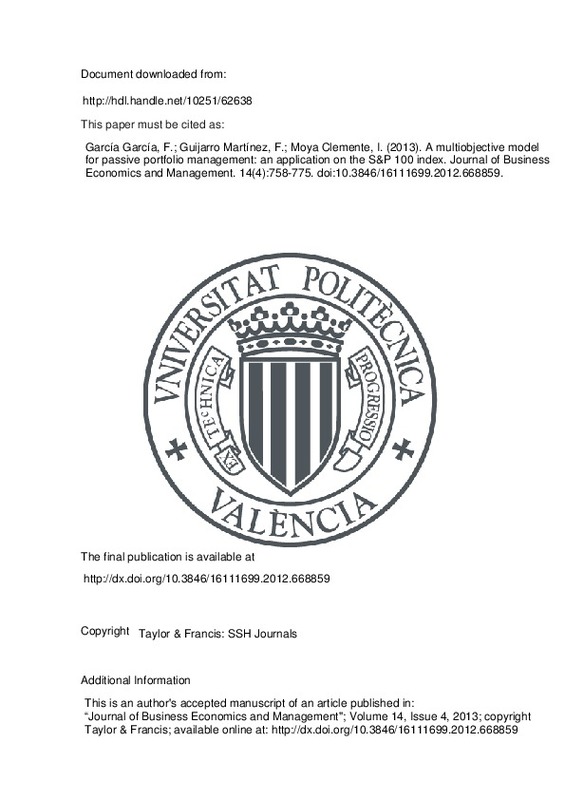Aktan, B., Korsakienė, R., & Smaliukienė, R. (2010). TIME‐VARYING VOLATILITY MODELLING OF BALTIC STOCK MARKETS. Journal of Business Economics and Management, 11(3), 511-532. doi:10.3846/jbem.2010.25
Ballestero, E., & Romero, C. (1991). A theorem connecting utility function optimization and compromise programming. Operations Research Letters, 10(7), 421-427. doi:10.1016/0167-6377(91)90045-q
Beasley, J. E. (1990). OR-Library: Distributing Test Problems by Electronic Mail. Journal of the Operational Research Society, 41(11), 1069-1072. doi:10.1057/jors.1990.166
[+]
Aktan, B., Korsakienė, R., & Smaliukienė, R. (2010). TIME‐VARYING VOLATILITY MODELLING OF BALTIC STOCK MARKETS. Journal of Business Economics and Management, 11(3), 511-532. doi:10.3846/jbem.2010.25
Ballestero, E., & Romero, C. (1991). A theorem connecting utility function optimization and compromise programming. Operations Research Letters, 10(7), 421-427. doi:10.1016/0167-6377(91)90045-q
Beasley, J. E. (1990). OR-Library: Distributing Test Problems by Electronic Mail. Journal of the Operational Research Society, 41(11), 1069-1072. doi:10.1057/jors.1990.166
Beasley, J. E., Meade, N., & Chang, T.-J. (2003). An evolutionary heuristic for the index tracking problem. European Journal of Operational Research, 148(3), 621-643. doi:10.1016/s0377-2217(02)00425-3
Canakgoz, N. A., & Beasley, J. E. (2009). Mixed-integer programming approaches for index tracking and enhanced indexation. European Journal of Operational Research, 196(1), 384-399. doi:10.1016/j.ejor.2008.03.015
Connor, G., & Leland, H. (1995). Cash Management for Index Tracking. Financial Analysts Journal, 51(6), 75-80. doi:10.2469/faj.v51.n6.1952
Corielli, F., & Marcellino, M. (2006). Factor based index tracking. Journal of Banking & Finance, 30(8), 2215-2233. doi:10.1016/j.jbankfin.2005.07.012
Derigs, U., & Nickel, N.-H. (2004). On a Local-Search Heuristic for a Class of Tracking Error Minimization Problems in Portfolio Management. Annals of Operations Research, 131(1-4), 45-77. doi:10.1023/b:anor.0000039512.98833.5a
Dose, C., & Cincotti, S. (2005). Clustering of financial time series with application to index and enhanced index tracking portfolio. Physica A: Statistical Mechanics and its Applications, 355(1), 145-151. doi:10.1016/j.physa.2005.02.078
Focardi, S. M., & Fabozzi 3, F. J. (2004). A methodology for index tracking based on time-series clustering. Quantitative Finance, 4(4), 417-425. doi:10.1080/14697680400008668
Gaivoronski, A. A., Krylov, S., & van der Wijst, N. (2005). Optimal portfolio selection and dynamic benchmark tracking. European Journal of Operational Research, 163(1), 115-131. doi:10.1016/j.ejor.2003.12.001
Hallerbach, W. G., & Spronk, J. (2002). The relevance of MCDM for financial decisions. Journal of Multi-Criteria Decision Analysis, 11(4-5), 187-195. doi:10.1002/mcda.328
Jarrett, J. E., & Schilling, J. (2008). DAILY VARIATION AND PREDICTING STOCK MARKET RETURNS FOR THE FRANKFURTER BÖRSE (STOCK MARKET). Journal of Business Economics and Management, 9(3), 189-198. doi:10.3846/1611-1699.2008.9.189-198
Roll, R. (1992). A Mean/Variance Analysis of Tracking Error. The Journal of Portfolio Management, 18(4), 13-22. doi:10.3905/jpm.1992.701922
Rudolf, M., Wolter, H.-J., & Zimmermann, H. (1999). A linear model for tracking error minimization. Journal of Banking & Finance, 23(1), 85-103. doi:10.1016/s0378-4266(98)00076-4
Ruiz-Torrubiano, R., & Suárez, A. (2008). A hybrid optimization approach to index tracking. Annals of Operations Research, 166(1), 57-71. doi:10.1007/s10479-008-0404-4
Rutkauskas, A. V., & Stasytyte, V. (s. f.). Decision Making Strategies in Global Exchange and Capital Markets. Advances and Innovations in Systems, Computing Sciences and Software Engineering, 17-22. doi:10.1007/978-1-4020-6264-3_4
Tabata, Y., & Takeda, E. (1995). Bicriteria Optimization Problem of Designing an Index Fund. Journal of the Operational Research Society, 46(8), 1023-1032. doi:10.1057/jors.1995.139
Teresienė, D. (2009). LITHUANIAN STOCK MARKET ANALYSIS USING A SET OF GARCH MODELS. Journal of Business Economics and Management, 10(4), 349-360. doi:10.3846/1611-1699.2009.10.349-360
[-]







![[Cerrado]](/themes/UPV/images/candado.png)


